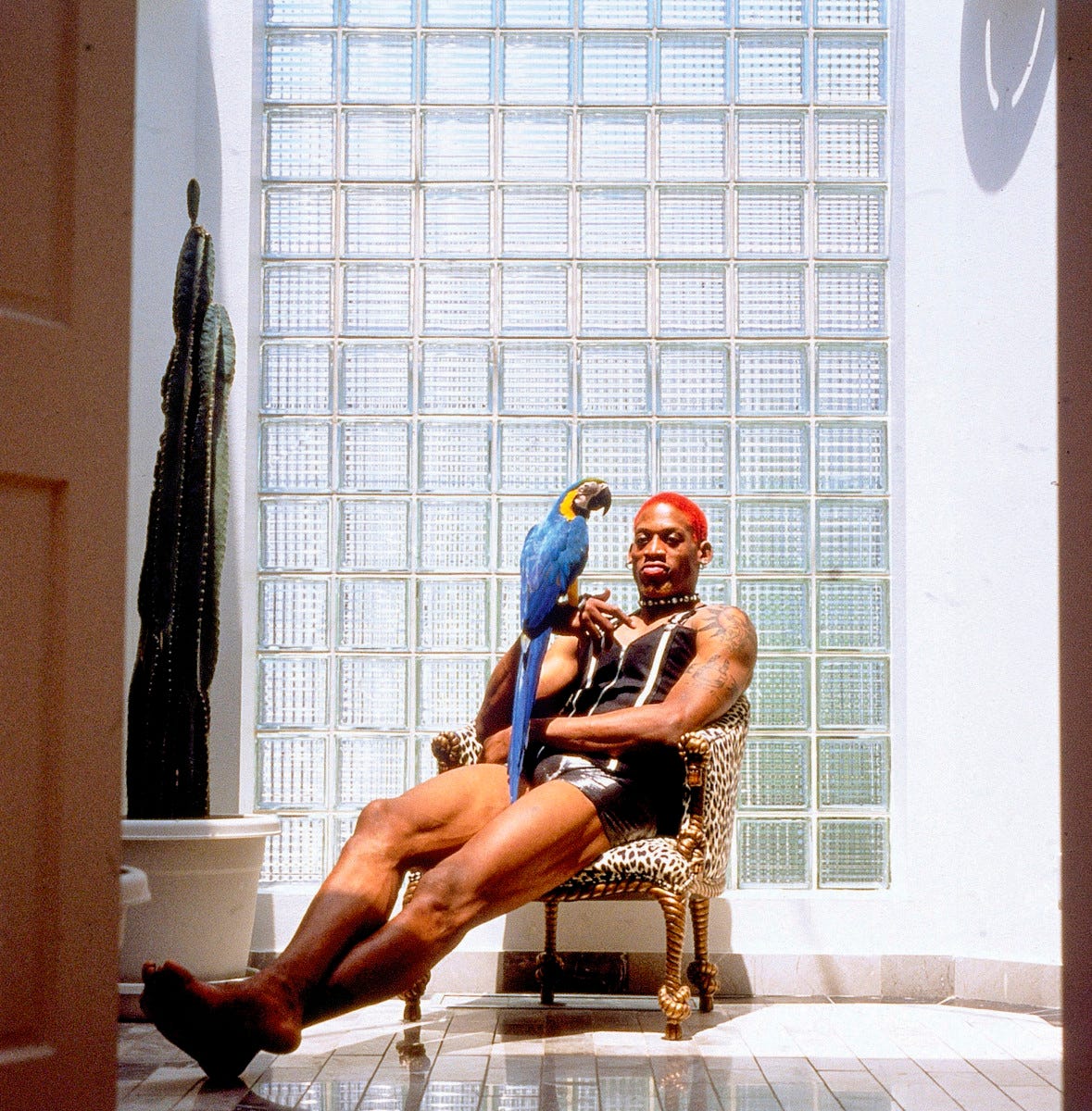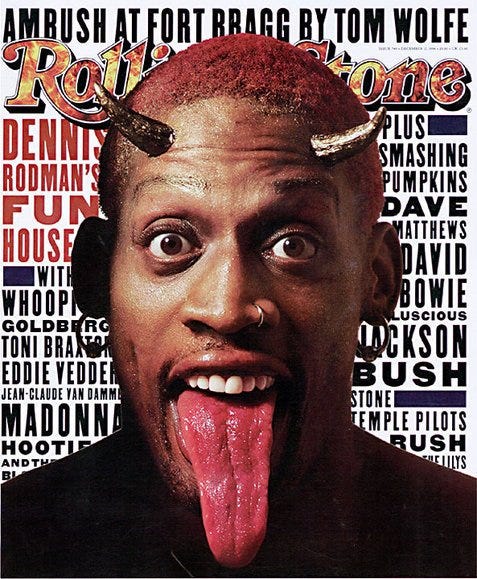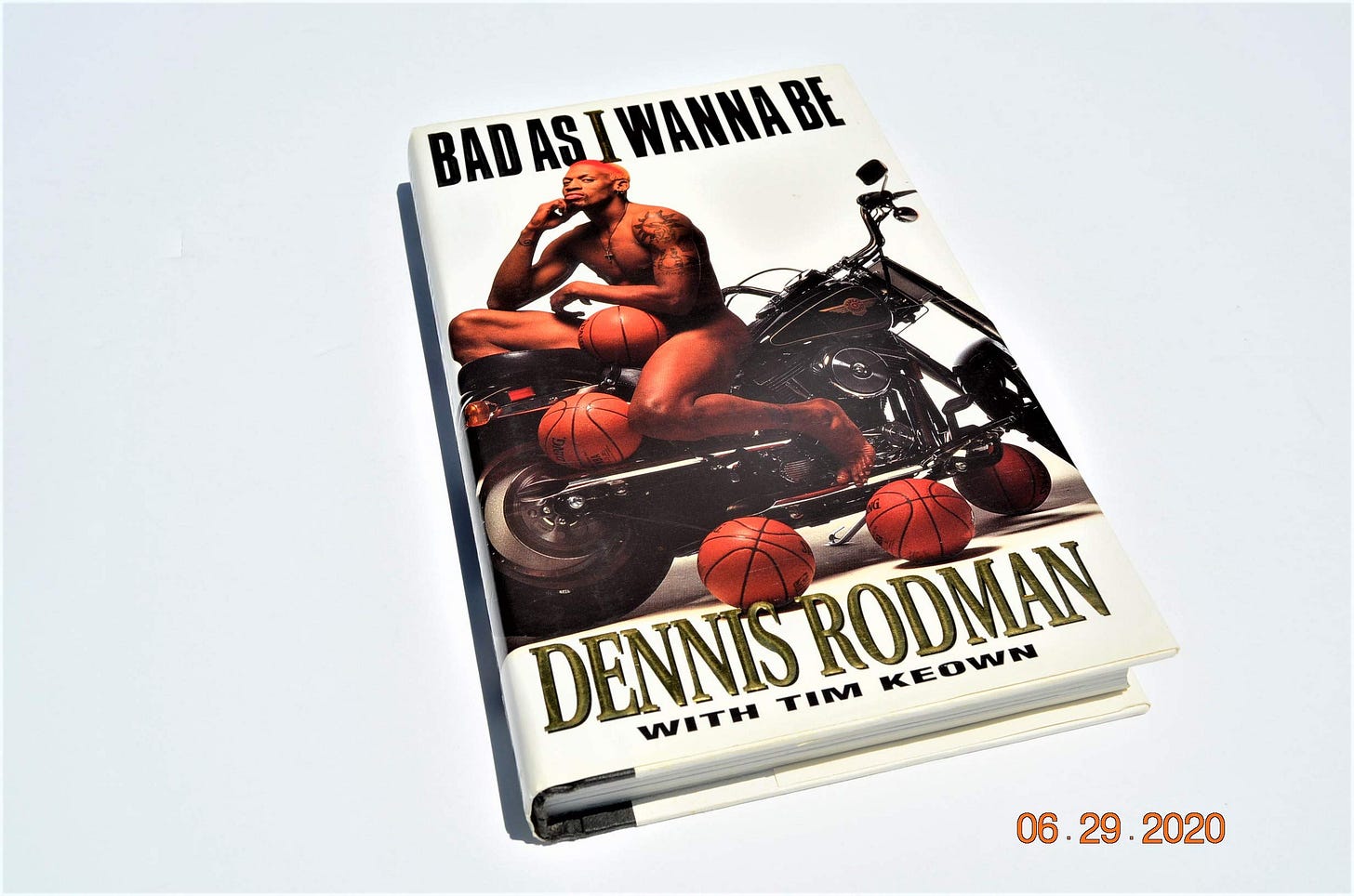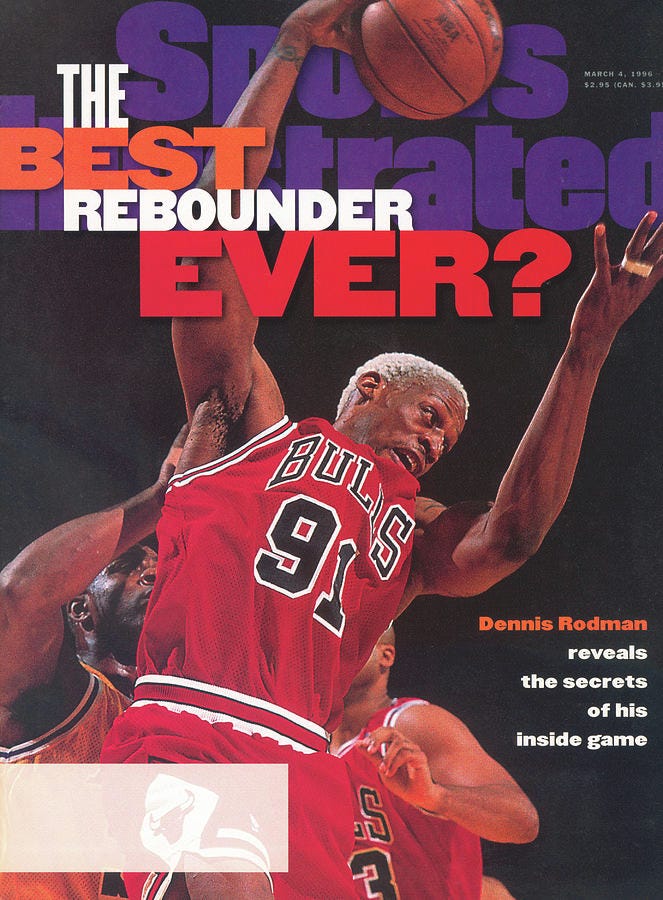Sidebar: Dennis Rodman's "Rare Bird" cover
The most provocative Sports Illustrated basketball cover of the 90s, Michael Silver talks "Walk on the Wild Side," and more.
Hi everyone. Welcome to my newsletter companion to “Cover Story,” a basketball book I wrote which is set for release on October 19th and is available for pre-order here. If you want to tell your followers about my book, feel free to share this tweet or this Instagram post. If you’re not a newsletter subscriber, click here to make sure you get every post in your inbox.
Dennis Rodman’s 1995 Sports Illustrated cover doesn’t need an introduction. It is one of those classic images which I feel every single basketball fan has seared into their memories. Whether it is the provocative cover image, the blue macaw, or the cover story filled with out-of-this-world quotes, it is truly the RARE BIRD of sports covers.
Through the lens of writer Michael Silver, photographer John McDonough, and friend Dwight Manley, the “Rare Bird” chapter in “Cover Story” provides a behind-the-scenes look at the four-day, three-state journey which ended with Rodman on the cover of one of the best-selling May covers in Sports Illustrated history.
The original idea for the Dennis Rodman chapter was to center it around an unreleased 1994 cover (pictured above) which featured co-cover star (and later girlfriend) Madonna. The backstory of how this magazine cover ended up being shelved is summarized in this Twitter thread, but it is also worth reading this article for context.
(I’m on pace to share my entire original book proposal, and honestly it’s pretty fascinating to see how much the final version of the book diverged from it. But also oh shit, now I’m freaking out about whether I made the right choices… let’s move on.)
As I started to think about where Dennis Rodman’s story fit with the larger themes of the book, it was an easy decision to pivot the chapter towards “Rare Bird,” which captured a transformational period for the Spurs forward and became the launching pad for The Worm’s ascent as a celebrity figure.
Dennis Rodman became the most taboo subject in basketball (in all of sports??). It wasn’t just the hairdos, piercings, and tattoos; or the tamper tantrums against referees, photographer(s), and head coaches; it was because of how open he was to having conversations which the mainstream media wasn’t (and still isn’t) ready for.
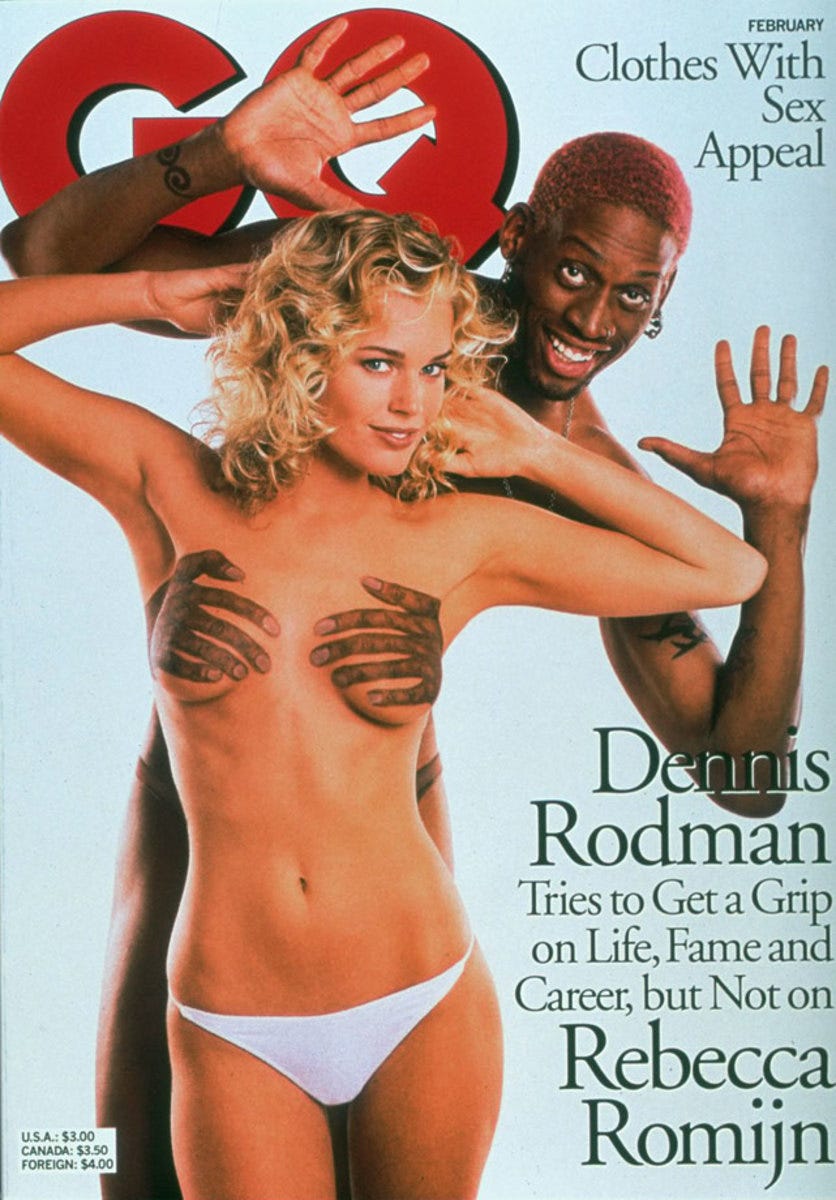
Rodman spoke at-length to Michael Silver about (to the ire of many Sports Illustrated readers who voiced their anger via reader mail) his sexuality in the “Rare Bird” cover story. At a time when homosexuality wasn’t discussed by the public (and certainly not in male locker rooms) in an open-minded way, Rodman embraced the fluidity of his sexual preferences and became a voice for a huge segment of people who felt marginalized by the public.
It’s easy to forget that part of Dennis Rodman’s story especially when his narrative was shaped by the more controversial headlines thanks to his antics including: kicking photographer during a game, throwing a pack of ice at head coach Bob Hill after being pulled from a (preseason) game, disappearing to Las Vegas in the middle of a season, and appearing on WCW’s Monday Night Nitro during an NBA Finals off-day.
There was another side to Dennis Rodman’s story. He was also someone who used his ever-growing platform to share his truths.
There was no bigger platform than his 1996 autobiography “Bad as I Wanna Be,” which arrived in bookstores as a best-seller after “Rare Bird” became one of the most-talked-about magazine covers in 1995.
I still remember purchasing a copy of “Bad as I Wanna Be” as a teenager (or probably what actually happened was: I went to a local bookstore and asked my mom to buy it for me and hoped she wouldn’t judge a book by its cover) and devouring it in one sitting. It was unlike any traditional sports bio I had read up to that point in my life.
A few excerpts from the book:
On what he was really doing on a February evening in 1993 when police found him asleep in his truck with a gun on his lap:
“I couldn’t be what society wanted an athlete to be. I couldn’t be the good soldier and the happy teammate and the good man off the court… The guy I wanted to kill was the person on the outside. The guy on the inside was fine, he just wasn’t getting out much.”
On the NBA and its marketing strategy:
“I’m not like the other guys in the NBA. I’m different, and it goes beyond the way I look and the things I do off the court. Here’s the main difference: I speak my mind. Everybody else is going to do what they're told because they’re the NBA Kids. They have to say something that won’t burn their daddy’s feet, and that daddy is Commissioner David Stern.”
On the art of rebounding:
“I’ve taken one part of the game and made it into an art form. I’ve taken this ugly stepchild and made it beautiful. Rebounding is grunt work—like working the graveyard shift as an airport janitor—and now it’s being recognized as a pivotal, elegant part of the game.”
Revisiting the text over two decades later, it strikes a more honest and thought-provoking tone than I remember.
The most eye-opening passages reading “Bad as I Wanna Be” are the parts where Rodman dives into his sexuality and addresses a question on everyone’s mind at the time: WAS DENNIS RODMAN GAY?
He explained in the book that he was mentally bisexual, admitted to having fantasized about being with a man, before adding:
“To hang out in a gay bar or put on a sequined halter top makes me feel like a total person and not just a one dimensional man… I’m not gay. I would tell you if I was. If I go to a gay bar, it doesn’t mean that I want another man to put his tongue down my throat—no, it means I want to be a whole individual. It means I’m comfortable dealing with different people in different situations. It means I’m willing to go out there in the world and see how different people live their lives. There’s nothing wrong with that.”
If you ask someone about “Bad as I Wanna Be” today, they might only remember the wedding dress publicity stunt during his book tour. But beneath all the promotional stunts and controversial headlines, Rodman was someone who always tried to convey a very basic message: IT IS OKAY TO BE YOURSELF AND IT IS OKAY TO BE DIFFERENT.
The success of “Bad as I Wanna Be” spawned a second book titled “Walk on the Wild Side,” which Rodman worked on with Michael Silver, the same writer who penned the “Rare Bird” cover story. I don’t remember much about this book, except for the chapter where Rodman talked about wanting to be cryogenically frozen (I might need to check if I imagined this) which made me think about my mortality for two weeks straight as a teen.
Silver was working for Sports Illustrated and had to turn down the opportunity to write “Bad as I Wanna Be” after the magazine didn’t agree to a proposal to take a week off each month to work on the book. He wasn’t going to miss a second chance to work with Rodman again.
“I had turned down the best-selling autobiography in sports history,” Silver told me.
Dwight Manley (Rodman’s close friend and, at this point, his agent) invited Silver to Game 1 of the 1996 NBA Finals between the Chicago Bulls and Seattle Supersonics with the intention of asking him to write “Walk on the Wild Side.” Silver flew to Chicago and realized he was seated courtside next to Pearl Jam’s Jeff Ament (another close friend of Rodman’s). They would all end up partying the night away. As some point in the evening, the Sports Illustrated writer agreed to be part of the project.
Working on a book with Dennis Rodman was a one-of-a-kind experience. Silver remembers the book process going something like this: he would get a phone call from Rodman, book a flight, party with him for two days, “and then, he would say, ‘bro, turn on your tape recorder,’ and we’d have an incredible hour-and-a-half conversation.”
This was how Silver found himself at the Chicago Navy Pier on December 31, 1996. It was New Year’s Eve. Rodman had booked two floors at the Ambassador hotel, paid Seattle-based rock band Candlebox to be a guest performer at his party, and spent five figures on a custom gown to complete his preferred look for the evening: a psychedelic version of Cleopatra.
Wearing a gold gladiator’s helmet, a purple-feather Mardi Gras mask, a sparkling cape made of gold and purple sequins, and a shield to cover his private parts, Rodman’s party eventually moved to one of his favorite local club hangouts Crobar before he, a group of friends, and Silver, boarded a tour bus at four in the morning to a Joliet, Illinois, riverboat casino.
When Silver woke up the next morning, he found himself on a boat watching the 1997 Rose Bowl between the Ohio State Buckeyes and Arizona State Sun Devils. “I loved watching football with Dennis,” Silver told me. “He had a great way of crystallizing things about football. He would boil things down so brilliantly.”
This overnight adventure ended up being the opening scene in the first chapter of “Walk on the Wild Side,” a book I’ll forever remember as the one about being cryogenically frozen.
I’ll be back on Friday to talk about the most renowned Sports Illustrated magazine collector in the world.
Thanks for reading the newsletter. Feel free to subscribe if it’s your first time reading. You can pre-order “Cover Story” here and find me on Twitter and Instagram. Email me if you want to chat.




